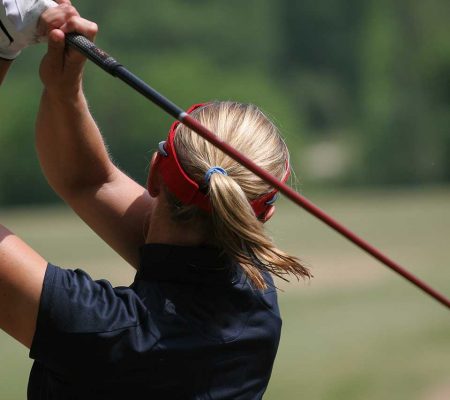Get into the Swing of Spring: 6 Tips to Prevent Golfer’s Elbow & Other Injuries
As soon as spring starts to warm up, many of us start thinking of getting out on the green! But after a long winter hiatus from the course, it’s important to review golf injury prevention, including the ubiquitous golfer’s elbow.
There’s nothing like pain to take the zing out of your swing, taking you away from your favorite hobby. It’s also important to note that golfer’s elbow (and the similar condition of tennis elbow) isn’t exclusive to its namesake. Rock climbers, tennis players, racquetball, and pickleball players all experience this affliction as well.
So, how do you prevent golfer’s elbow and keep your putts pain-free?
What is Golfer’s Elbow?
Golfer’s elbow is the common term for medial epicondylitis. It results in arm pain, tenderness, and general discomfort between the elbow and wrist. Those experiencing golfer’s elbow may feel stiffness, tingling (a funny-bone feeling), trouble gripping, or weakness in the hands and wrists. Pain in the elbow that radiates down the arm is also common.
Golfers may first notice flair-ups on and off the course. Some golfers describe a twinge post-play, others notice pain during a putt or chip shot. Some golfers report the pain occurring shortly after a game or waking up the next day with a sore forearm, hand, or wrist.
The pain of golfer’s elbow comes from damaged and inflamed tendons and muscles in your lower arm, hand, and wrist. Repeat motion causes pain and irritation. Throwing, swinging, and even weightlifting may contribute to and exacerbate this lower-arm pain.
As with many repetitive use injuries, the best course of treatment varies by individual. If you experience pain and stiffness, you should schedule an appointment with an orthopedic specialist at OHOW. We will assess the concern and advise you on the right therapy to alleviate your pain.
With golfer’s elbow, surgical intervention often isn’t necessary. Most patients recover with the right combination of rest, physical therapy, and supportive care, but it’s important to work with your doctor to determine what’s best for you. As with many sports injuries, an ounce of prevention is often worth a pound of cure.
Here are 6 simple tips to prevent golfer’s elbow and other spring sports injuries.
1. Use Proper Equipment
When doing any sport, proper equipment is essential for injury prevention. Golfer’s elbow is no exception to this rule. Use high-quality clubs whenever possible. If you play tennis, pickleball, racquetball, or other sports, use a racquet correctly sized to your body.
As with any spring sports injury prevention, proper footwear is also important. While the right golf shoes won’t prevent golfer’s elbow directly, they will help you use the correct form and avoid bad habits that lead to injuries down the road.
2. Warm-Up and Stretch Before Play
Golf is considered a leisure sport, but as any golfer knows, carrying clubs around an 18 hole golf course is a workout! Even if you opt for a golf cart, you are twisting, turning, lifting, and moving throughout the play.
Warm-up for activity by stretching and engaging in light cardio (like a brisk walk) before you hit the course. In addition to stretching and warming up, grab a water bottle. Stay hydrated throughout your game so you remain alert and energetic.
3. Listen to Your Body
If you notice your body is sending you signals, LISTEN! Pain is our body telling us something is wrong. Avoid the tendency to “push through the pain” and don’t be afraid to play nine holes instead of a full 18.
It’s especially important to listen to your body’s signals if you are coming back to the game after a break. In the spring, it takes time to get back into the “swing” of your sport. Don’t push yourself to go the full course if it doesn’t feel right.
4. Watch Your Form
A proper golf form prevents a myriad of issues and injuries. OHOW’s Matt Mestelle, PT, MPT, is certified by the Titleist Performance Institute on golf assessments. These golf form assessments analyze data to discover movement dysfunctions and inconsistent patterns that lead to poor performance and injury.
If you haven’t had your swing analyzed, this information will help you make necessary adjustments to prevent injuries like golfer’s elbow. A golf physical assessment can also prevent back stress and injury to the lower joints during your game.
5. Cross-Train
Cross-training is essential for injury prevention in all sports. Golfers benefit from exercises to build core strength (necessary for those long drives), promote flexibility, and build stamina. Walking, jogging, weightlifting, and even yoga can help golfers improve their game and their health.
When we play only one sport, we may miss opportunities to build muscles that protect us from injury. For example, runners who don’t weight train may get weak glutes leading to runner’s knee. Golfers can ensure they stay fit and healthy by adding other complementary activities to their golf routine.
6. Build Wrist Strength
Ultimately, golfer’s elbow is often due to weakness in the wrists, hands, lower arms, shoulders and possibly your core. You can overcome this weakness by working with a physical therapist on strength-building exercises to target the wrist and forearm. Forearm strength will help you avoid other issues like carpal tunnel syndrome and similar repeat-motion injuries.
If you notice any signs of golfer’s elbow, schedule a consultation with a physical therapist here at Orthopaedic Hospital of Wisconsin, so we can help you plan a regimen to counteract further injury. Request an appointment online or call 414-961-6800 to set up a consultation with a specialist.


